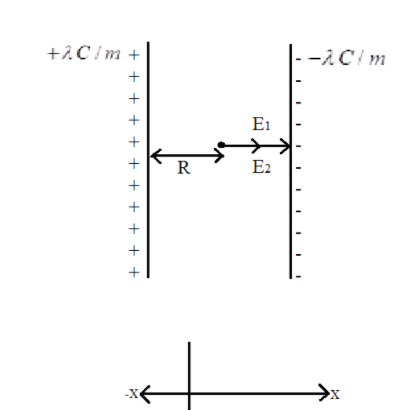
Two parallel infinite line charges with linear charge densities $+\lambda \,C/m$and $-\lambda \,C/m$ are placed at a distance of $2R$ in free space. What is the electric field midway between the two-line charges?
$\begin{align}
& A.\,\,Zero \\
& B.\,\,\dfrac{2\lambda }{\pi {{\varepsilon }_{0}}R}N/C \\
& C.\,\,\dfrac{\lambda }{\pi {{\varepsilon }_{0}}R}N/C \\
& D.\,\,\dfrac{\lambda }{2\pi {{\varepsilon }_{0}}R}N/C \\
\end{align}$
Answer
561k+ views
Hint: Electric field for a line charge can be calculated using Coulomb’s Law, which can help to get the electric force between the two line charges and since the details regarding the linear charge densities and the distance between them are given, then to get the net electric field between the two-line charges, we just need to add the electric field of both line charges individually.
Formula used:
$Electric\,Field(E)=\dfrac{\lambda }{\pi {{\varepsilon }_{0}}d}$
Complete step by step answer:
According to the question, the magnitude of the charge density is $\lambda \,C/m$ and the distance between the two line charges is given, which means $d=2R$, the given scenario is depicted in the diagram shown below.

So, the electric field due to line charge $(1)$ is:
${{E}_{1}}=\dfrac{\lambda }{\pi {{\varepsilon }_{0}}(2R)}N/C$
And, the electric field due to line charge $(2)$ is:
${{E}_{2}}=\dfrac{\lambda }{\pi {{\varepsilon }_{0}}(2R)}N/C$
Hence, the electric field mid-way between the two-line charges can be written as:
${{E}_{net}}={{E}_{1}}+{{E}_{2}}$
Substituting the value of both the line charge electric field, we get:
$\begin{align}
& \Rightarrow {{E}_{net}}=(\dfrac{\lambda }{2\pi {{\varepsilon }_{0}}R}+\dfrac{\lambda }{2\pi {{\varepsilon }_{0}}R})N/C \\
& \therefore {{E}_{net}}=\dfrac{\lambda }{\pi {{\varepsilon }_{0}}R}N/C \\
\end{align}$
Note:
It’s better to construct a diagram for the details given in the question, which helps to understand the problem easily and also shows a way of getting the solution. In this question, after marking the details given in a diagram, it was easy to find the net electric field by just placing the values in the formula.
Formula used:
$Electric\,Field(E)=\dfrac{\lambda }{\pi {{\varepsilon }_{0}}d}$
Complete step by step answer:
According to the question, the magnitude of the charge density is $\lambda \,C/m$ and the distance between the two line charges is given, which means $d=2R$, the given scenario is depicted in the diagram shown below.

So, the electric field due to line charge $(1)$ is:
${{E}_{1}}=\dfrac{\lambda }{\pi {{\varepsilon }_{0}}(2R)}N/C$
And, the electric field due to line charge $(2)$ is:
${{E}_{2}}=\dfrac{\lambda }{\pi {{\varepsilon }_{0}}(2R)}N/C$
Hence, the electric field mid-way between the two-line charges can be written as:
${{E}_{net}}={{E}_{1}}+{{E}_{2}}$
Substituting the value of both the line charge electric field, we get:
$\begin{align}
& \Rightarrow {{E}_{net}}=(\dfrac{\lambda }{2\pi {{\varepsilon }_{0}}R}+\dfrac{\lambda }{2\pi {{\varepsilon }_{0}}R})N/C \\
& \therefore {{E}_{net}}=\dfrac{\lambda }{\pi {{\varepsilon }_{0}}R}N/C \\
\end{align}$
Note:
It’s better to construct a diagram for the details given in the question, which helps to understand the problem easily and also shows a way of getting the solution. In this question, after marking the details given in a diagram, it was easy to find the net electric field by just placing the values in the formula.
Recently Updated Pages
Master Class 12 Economics: Engaging Questions & Answers for Success

Master Class 12 Maths: Engaging Questions & Answers for Success

Master Class 12 Biology: Engaging Questions & Answers for Success

Master Class 12 Physics: Engaging Questions & Answers for Success

Basicity of sulphurous acid and sulphuric acid are

Master Class 12 Business Studies: Engaging Questions & Answers for Success

Trending doubts
How much time does it take to bleed after eating p class 12 biology CBSE

Explain sex determination in humans with line diag class 12 biology CBSE

Differentiate between homogeneous and heterogeneous class 12 chemistry CBSE

When was the first election held in India a 194748 class 12 sst CBSE

Explain sex determination in humans with the help of class 12 biology CBSE

December 10th of 1948 is an important day in the history class 12 sst CBSE




